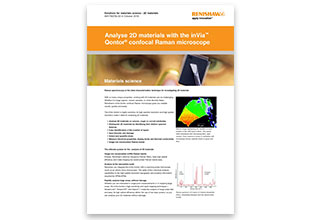No momento esta página não está disponível em seu idioma. Você pode ver uma tradução automatizada utilizando o Google Translate. Não somos responsáveis pelo fornecimento deste serviço e não podemos verificar os resultados.
Se você necessitar mais ajuda fale conosco.
Characterise carbon and 2D materials with Raman microscopy
The massive range of consumer products that use carbon-based materials—and the promise of 2D materials for future technologies—make these key application areas for Raman spectroscopy.
You can use Raman to identify all the forms of carbon, including graphene, carbon nanotubes (CNT), graphite, diamond, and diamond-like carbon (DLC). You can also study 2D materials such as MoS2, hBN, and WSe2.
Analyse all forms of carbon
Renishaw's Raman systems are being used to research, develop, and control the quality of carbon materials. You can determine:
- the number of graphene layers, and their defects, doping and strain
- Diamond Like Carbon (DLC) thickness and hybridised composition (sp2 and sp3)
- Carbon Nanotube (CNT) diameter and functionalisation
- diamond stress, purity and origin (synthetic or natural)
- the properties of C60 and other fullerenes
- the structural composition of amorphous carbons
White light and Raman images of graphene flakes on a silicon substrate. The Raman image is colour coded by number layers in the graphene: single-layer (red); dual-layer (blue); and multi-layer (green).
Raman and photoluminescence images of a hot-filament-grown CVD diamond film.
The Raman image indicates the intensity of the 1332 cm-1 diamond band. Darker regions have higher graphitic content; this leads to lower laser penetration and a weaker diamond signal.
The photoluminescence image is based on the intensity of the 1.77 eV band (red, most likely related to contamination from the filament during growth) and the intensity of the 1.95 eV band (blue, [N-V]- nitrogen vacancy).
Monolayers and thin films
The massive range of consumer products that use carbon-based materials—and the promise of 2D materials for future technologies—make these key application areas for Raman spectroscopy.
Some of these new materials consist of single, or just a few, atomic layers. The high sensitivity of Renishaw's Raman systems makes identifying and analysing them quick and easy.
Analyse CVD graphene grown on copper foils
Renishaw's LiveTrack™ focus-tracking technology maintains sample focus, even when mapping large areas that are not flat.
More signal, no damage
Some thin carbon films, such as DLC, can be damaged by high laser power densities. With Renishaw's line-focus laser illumination technology, power densities are reduced, but total laser power is retained. You can collect high quality data rapidly, without damaging your samples.
Nanotechnology
The high spatial resolution of Renishaw's inVia confocal Raman microscope makes it suitable for studying the structure and defects of nanomaterials, such as graphene and CNTs.
Renishaw can combine Raman analysis with scanning probe microscopes (such as atomic force microscopes). These systems add chemical analysis capabilities to the high spatial resolution topography and property information acquired by SPMs/AFMs. You can also use tip-enhanced Raman spectroscopy (TERS) to acquire nanometre-scale Raman chemical information.
All encompassing spectra
Renishaw's SynchroScan produces high-resolution wide-range spectra. Collecting data covering the entire Raman and photoluminescence range is simple and fast. For example, you can:
- see carbon nanotube radial-breathing modes (RBMs), with the G and 2D bands, together
- study photoluminescence features associated with defects in diamond, as well as its Raman spectrum
We're here when you need us
To find out more about this application area, or an application that isn't covered here, contact our applications team.
Contact our applications team
On-demand webinars:
Raman spectroscopy of carbon materials
From diamond and carbon nanotubes (CNT) to graphene; carbon materials come in various forms and have a wide range of applications.
You can use Raman spectra to differentiate between the different forms of carbon. See how the G, D, 2D and T bands of carbon can reveal crystallinity, defects, layer structures and sp2/sp3hybridisation.
Watch LiveTrackTM in action on uneven graphene substrates, multi-wavelength Raman analysis for sizing single-walled carbon nanotubes (SWCNTs), and full automation for industrial diamond-like carbon (DLC) quality control.
Watch the webinar
Growth & Characterisation of 2D Materials Beyond Graphene
Investigation into the physics and technology of graphene in the past decade has triggered research into a large family of similar Van der Waals structures.
One such class of materials that is receiving a huge amount of attention is Transition Metal DiChalcogenides (TMDCs) which have shown immense potential towards both electronics and optoelectronics applications. This webinar will focus on recent advances in growth of 2D materials and on Raman characterisation, and elucidate the interplay between process engineering and materials characterisation.
The webinar comprises two talks:
Characterisation of 2D materials and heterostructures - Dr Tim Batten, Renishaw, UK
Deposition of 2D materials and heterostructures - Dr Ravi Sundaram , Oxford Instruments, UK
Related stories
The world's lightest mechanical watch
In January 2017, the world's lightest mechanical chronograph watch was unveiled in Geneva, Switzerland, showcasing an innovative composite material containing graphene. Now the research behind the project has been published with the Renishaw inVia Raman microscope playing an important role in the development of the material.
Quality control analysis at New Plasma Technologies
New Plasma Technologies (NPT), based in Moscow, Russia, uses a Renishaw inVia confocal Raman microscope for investigating the structure and chemical properties of materials, non-destructively.















